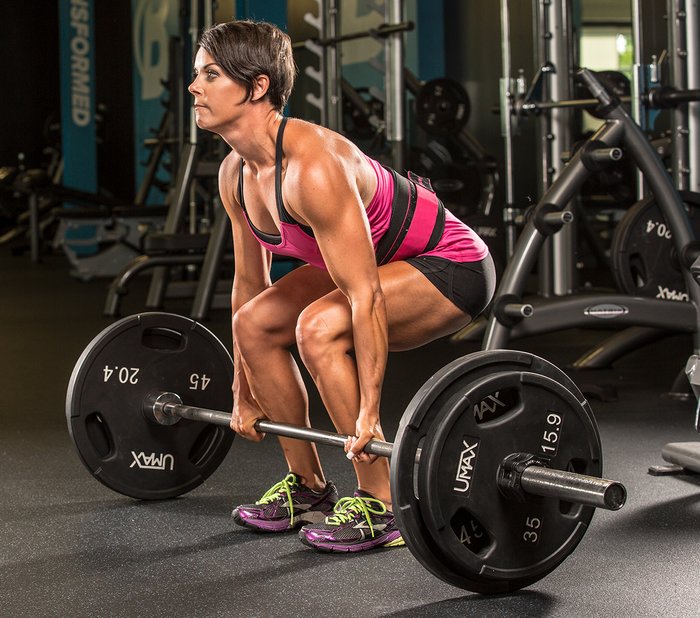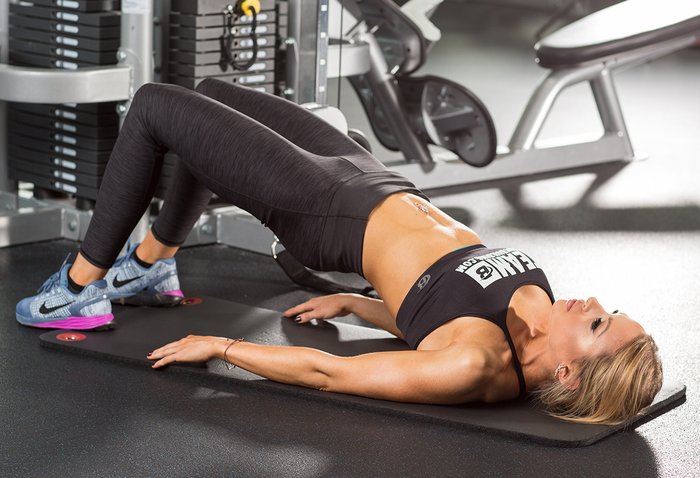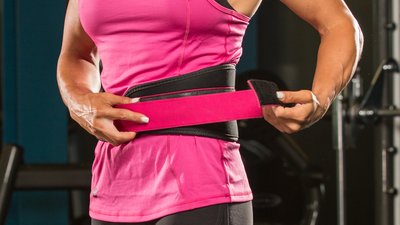Think about the last time you ran or jumped, pulled a heavy weight off the floor, or powered through a squat. Now think about everything that helped to support you during these movements. A tight core and strong legs were definitely major players. But what else helped? Maybe you chalked up before heavy lifts, or used raised-heel squat shoes. How about this: Did you wear a belt?
In CrossFit boxes and many commercial gyms, weightlifting belts have become very popular among women. It's not just during, say, heavy max-effort squat or deadlift attempts, you'll also see them during things like these:
- Overhead press or push-press work
- Olympic lifts, both heavy and light
- Barbell or dumbbell rows
- Metcon workouts
The reason why is no surprise: Belts make you able to lift more weight! But, by trying to protect your lower back through the hardest reps, you could inadvertently be wrecking your pelvic floor, which can have far-reaching consequences that you'd definitely rather avoid.
Men have pelvic floors, too, but I'm writing this piece to address us ladies. If you take your lifting seriously, you need to know this!
What is the Pelvic Floor?
Rather than a single muscle, the pelvic floor is a group of muscles at the bottom of your pelvis. In women, these sit much like a hammock—or a trampoline—and support your pelvic organs, including the bowel, bladder, and uterus. They play a major role in controlling your bladder and bowel, preventing you from leaking and tooting at inopportune moments—like during heavy squats, box jumps, or even jumping rope. I'm sure a few fit girls out there know exactly what I'm talking about.

Pelvic floor muscles that are neither too tight nor weak are also important for enjoying pain-free sex, in providing support for a baby during pregnancy, and in working with the other muscles of your core to support your spine. Doctors are always telling us to strengthen these muscles, especially after childbirth and as we creep toward middle age.
As someone who lifts, you may think your pelvic floor is, by extension, as strong as your legs, back, or core. But you might be wrong.
The Role of a Weightlifting Belt
Working in the physical therapy and fitness world, I'm often asked by aspiring lifters whether they should train with a belt. When I ask questions about why they think they should, I find that most people don't have any idea what a belt does. They just feel like they should wear one. Why? Well, monkey see, monkey do.
Strapping on a belt isn't just about meeting the gym fashion quota or looking tough under the bar. Saying "it protects your back" also doesn't quite tell the whole story. The stiff fabric or leather of a belt allows you to brace against it, which in turn allows you to generate more of what is called "intra-abdominal pressure." The more pressure present, the more supported the spine is, and the heavier the weight you can lift.

While there are clearly performance-related pros to wearing a belt—increased stability throughout your core, reduced lower-back stress, and tactile feedback to press against—there are also some cons. For one, lifting belts can give you a false sense of security, leading you to potentially lift more weight than you can handle. They can also keep you from doing the hard work to build a truly strong core, making you reliant on the tool rather your own muscular strength and motor control.
How Training With a Belt Affects Your Pelvic Floor
Strapping on a weightlifting belt before going heavy on your lifts could be leading to or exacerbating an already weakened pelvic floor. Belts can be problematic precisely because of their greatest benefit: the increased amount of intra-abdominal pressure they allow you to generate. However, that pressure must go somewhere, and certainly isn't going through the stiff synthetic or leather material of a belt.
Unfortunately, the pelvic floor is exactly what bears the brunt. Over time, being exposed to all that force can actually make it weaker, and this can be even worse if, like one out of four women, you already suffer some type of dysfunction there.[1] For this reason, I encourage women not to wear belts for most of their training.
Going for a new squat or deadlift PR? Fine, wear it. The rest of the time, consider leaving it in the bag and focusing on learning how to better brace and generate some intra-abdominal pressure while limiting the downward force onto the pelvic floor. Yes, you'll probably have to lighten the weight you're lifting some of the time, but considering that also means your form will improve, I think it's worth the payoff.
What I want you to take away is this: The pelvic floor is a muscle group like any other. You can train it to be stronger, or you can unintentionally train it in such a way that can lead to dysfunction or injury. And if the constant use of a lifting belt could lead to symptoms like incontinence, pelvic organ prolapse, or pelvic pain, then it might not be worth the few extra pounds it gives you on that single lift.
How to Truly Strengthen Your Pelvic Floor
If using a belt, childbirth, or anything else has weakened your pelvic floor, all hope isn't lost. There are specific movements you can use to make these muscles stronger and improve their endurance, power, and functionality.
Specifically training the pelvic floor can be slightly complicated. If you have real problems with yours, it's worth working with a trained professional to ensure that you're preforming strengthening exercises correctly. In fact, strengthening these muscles incorrectly can make things worse!
Sorry ladies, but it isn't as easy as just performing Kegels. In fact, Kegels can actually aggravate, not relieve, a chronically tight pelvic floor.

While there's no substitute for a personal assessment, there are a pair of drills I can unequivocally recommend to all women with concerns about their pelvic floor. Both work to tie the core and hip stabilizer muscles together, because these two types of strength are integral to how the pelvic floor functions. Variations of glute bridges and planks are ideal here.
My two favorite variations are the glute bridge with march, and the exercise ball "stir the pot". Try to include the glute bridge with march most days of the week, and implement the exercise ball stir the pot into your training 2-3 times a week.
Glute Bridge with March
Directions:
- Lay on your back with your knees bent, and lift your hips off the ground. Maintain this position while squeezing your glutes and keeping your core engaged.
- Lift your left foot a few inches off the ground without allowing any movement or shifting to occur at the hips. Hold for a few seconds. Place it back on the ground and then lift your right foot off the ground, again maintaining a good position throughout the movement.
- Repeat this exercise for 10 reps on each side.
Exercise Ball Stir the Pot
Directions:
- Assume a plank position with your forearms on an exercise ball, your knees slightly bent, and your back maintaining its natural arch.
- Keeping this position, make a circle with your upper body while keeping your lower body stable.
- Go one way, and then the other way, again keeping everything else stable with only your arms moving. Try to go for 30 seconds!
Please note that if you are post-partum it is important to check with your physical therapist before jumping back in to core-specific work as you may not be ready for them and could suffer an injury.
Reference
- Wu, J. M., Vaughan, C. P., Goode, P. S., Redden, D. T., Burgio, K. L., Richter, H. E., & Markland, A. D. (2014). Prevalence and trends of symptomatic pelvic floor disorders in US women. Obstetrics and Gynecology, 123(1), 141.

